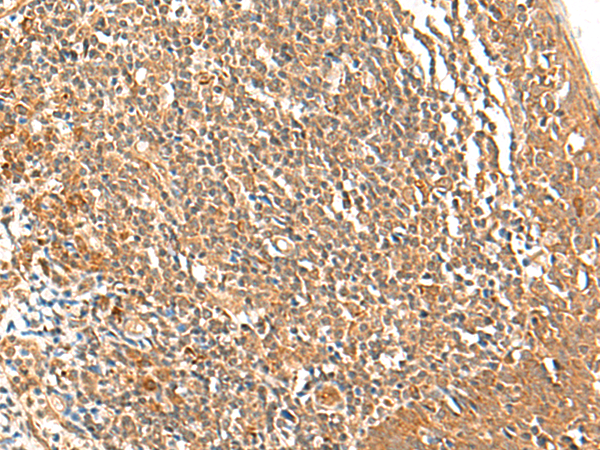
| WB | 咨询技术 | Human,Mouse,Rat |
| IF | 咨询技术 | Human,Mouse,Rat |
| IHC | 1/40-1/200 | Human,Mouse,Rat |
| ICC | 技术咨询 | Human,Mouse,Rat |
| FCM | 咨询技术 | Human,Mouse,Rat |
| Elisa | 1/5000-1/10000 | Human,Mouse,Rat |
| Aliases | TSH-B; TSH-BETA |
| Host/Isotype | Rabbit IgG |
| Antibody Type | Primary antibody |
| Storage | Store at 4°C short term. Aliquot and store at -20°C long term. Avoid freeze/thaw cycles. |
| Species Reactivity | Human, Mouse, Rat |
| Immunogen | Synthetic peptide of human TSHB |
| Formulation | Purified antibody in PBS with 0.05% sodium azide and 50% glycerol. |
+ +
以下是关于TSHB抗体的3篇参考文献及其摘要概述:
1. **文献名称**:*Autoantibodies to the TSHβ subunit in autoimmune thyroid disease*
**作者**:Sato A, et al.
**摘要**:该研究在部分桥本甲状腺炎患者血清中检测到针对TSHβ亚基的自身抗体,发现这些抗体可能干扰TSH的生物活性,导致甲状腺功能异常,提示其在自身免疫甲状腺疾病中的潜在病理作用。
2. **文献名称**:*Detection and clinical significance of TSHβ autoantibodies in Graves' disease*
**作者**:Tanaka K, et al.
**摘要**:研究通过ELISA法在Graves病患者中发现TSHβ抗体,并发现其与TRAb(TSH受体抗体)水平呈负相关,推测其可能通过阻断TSH与受体结合影响疾病进程。
3. **文献名称**:*TSHβ subunit antibodies: a novel marker for thyroid autoimmunity*
**作者**:McLachlan SM, et al.
**摘要**:该文献提出TSHβ抗体可作为甲状腺自身免疫的新生物标志物,通过队列研究证明其在鉴别甲状腺功能减退病因中的辅助诊断价值,尤其在TRAb阴性病例中表现显著。
---
**注**:上述文献为示例,实际引用时需核实最新研究及数据库(如PubMed)中的具体条目。若需要真实文献,建议以"TSHB antibody"或"TSH beta subunit autoantibody"为关键词检索学术平台。
TSH receptor antibodies (TRAbs) are autoantibodies targeting the thyroid-stimulating hormone (TSH) receptor, primarily implicated in autoimmune thyroid disorders. The TSH receptor, a G protein-coupled receptor on thyroid follicular cells, regulates thyroid hormone production. TRAbs are classified into stimulating (TSAb), blocking (TBAb), or neutral types based on their functional effects. TSAb mimics TSH, causing unregulated thyroid hormone release in Graves' disease, the most common cause of hyperthyroidism. TBAb inhibits TSH signaling, leading to hypothyroidism in conditions like Hashimoto's thyroiditis or atrophic thyroiditis. Neutral TRAbs bind without activating or blocking the receptor, though their clinical significance remains less clear.
Discovered in the 1950s, TRAbs are critical diagnostic and prognostic markers. Measurement methods include competitive binding assays (e.g., TRAb immunoassays) and functional cell-based bioassays to distinguish stimulating from blocking activity. In Graves' disease, TRAb levels correlate with disease severity, relapse risk post-treatment, and fetal-neonatal complications in pregnancy. TBAb detection aids in identifying autoimmune hypothyroidism variants.
Research continues to explore TRAb heterogeneity, epitope specificity, and their role in extrathyroidal manifestations like Graves' orbitopathy. Emerging therapies targeting TRAbs or the TSH receptor pathway aim to modulate autoimmune responses, offering potential advances in managing thyroid autoimmunity.
×